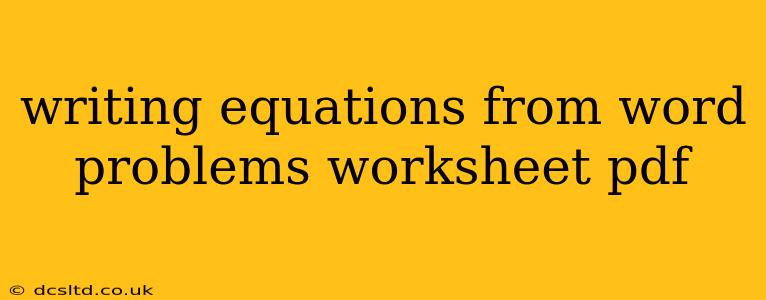Mastering the Art of Translating Word Problems into Equations: A Comprehensive Guide
Converting word problems into mathematical equations is a crucial skill in algebra and beyond. This guide will equip you with the strategies and techniques to confidently tackle even the most challenging word problems, transforming confusing sentences into solvable equations. We'll explore various problem types and provide clear examples to solidify your understanding. This isn't just about finding the answer; it's about developing the critical thinking needed to translate real-world scenarios into mathematical language.
Many students find this step—the translation from words to symbols—to be the most difficult part of solving word problems. This guide aims to make that process clearer and more manageable.
Understanding the Fundamentals: Keywords and Relationships
Before diving into complex problems, let's establish a strong foundation. Word problems rely on keywords and relationships to indicate the mathematical operations involved. Here are some key indicators:
- Addition (+): sum, total, more than, increased by, added to
- Subtraction (-): difference, less than, decreased by, subtracted from, minus
- Multiplication (×): product, times, multiplied by, of (often used with fractions or percentages)
- Division (÷): quotient, divided by, per, ratio
- Equals (=): is, are, equals, results in, is equal to
Breaking Down the Problem: A Step-by-Step Approach
Solving word problems effectively involves a systematic approach:
-
Read Carefully: Understand the problem thoroughly. Read it multiple times if necessary. Identify what information is given and what needs to be found.
-
Identify the Unknown: What are you trying to solve for? Assign a variable (e.g., x, y, z) to represent this unknown quantity.
-
Translate the Words into an Equation: Use the keywords and relationships to express the problem mathematically. This is the crucial step!
-
Solve the Equation: Use algebraic techniques to find the value of the variable.
-
Check Your Answer: Does your answer make sense in the context of the problem? Substitute the value back into the original word problem to verify your solution.
Common Types of Word Problems and How to Tackle Them
Let's look at some common types of word problems and strategies for translating them into equations:
1. Age Problems:
-
Example: John is 5 years older than Mary. The sum of their ages is 23. How old is Mary?
- Solution: Let x = Mary's age. Then John's age is x + 5. The equation becomes: x + (x + 5) = 23.
2. Distance-Rate-Time Problems:
-
Example: A car travels at 60 mph for 3 hours. How far did it travel?
- Solution: Distance = Rate × Time. The equation is: Distance = 60 mph × 3 hours.
3. Percentage Problems:
-
Example: A shirt is on sale for 20% off. The original price is $50. What is the sale price?
- Solution: Sale price = Original price - (Discount percentage × Original price). The equation is: Sale price = $50 - (0.20 × $50).
4. Mixture Problems:
-
Example: How many liters of a 20% solution must be added to 5 liters of a 50% solution to obtain a 30% solution?
- Solution: This involves setting up an equation based on the concentration of the solution and the total volume. This type of problem requires more advanced algebraic manipulation.
5. Number Problems:
-
Example: The sum of two consecutive numbers is 15. What are the numbers?
- Solution: Let x be the first number. The next consecutive number is x + 1. The equation is: x + (x + 1) = 15
H2: What are some common mistakes to avoid when writing equations from word problems?
A common mistake is misinterpreting the language used in the problem, leading to incorrect equations. For example, confusing "less than" with "less," or failing to properly translate phrases involving fractions or percentages. Another common error is neglecting to check the units and dimensions in the problem, leading to nonsensical answers. Lastly, students often rush the translation process, failing to fully understand the problem before attempting to write an equation.
H2: How can I improve my skills in translating word problems into equations?
Practice is key! Work through many different types of word problems, focusing on careful reading and precise translation. Start with simpler problems and gradually move to more complex ones. Use online resources, textbooks, and practice worksheets to enhance your skills. Consider breaking down complex problems into smaller, more manageable parts. Remember to always check your answer against the context of the problem.
H2: What resources are available to help me practice writing equations from word problems?
Numerous online resources offer practice problems and tutorials on translating word problems into equations. Khan Academy, for example, provides interactive exercises and videos covering various problem types. Textbooks often include sections dedicated to word problems with detailed solutions. Searching for "word problems worksheets PDF" online will yield numerous printable resources. Many websites provide customized worksheets tailored to specific skill levels.
By understanding the fundamental concepts, employing a step-by-step approach, and practicing regularly, you can master the art of converting word problems into equations and confidently tackle any mathematical challenge they present. Remember to break down complex problems and practice regularly to build your skills. This will not only help you excel in mathematics but also develop your critical thinking and problem-solving abilities for real-world applications.
